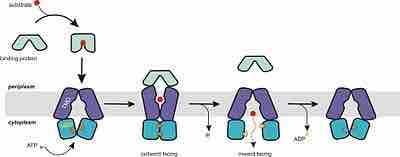ATP-binding cassette transporters (ABC-transporters) are members of a protein superfamily that is one of the largest and most ancient families with representatives in all extant phyla from prokaryotes to humans.
ABC transporters are transmembrane proteins that utilize the energy of adenosine triphosphate (ATP) hydrolysis to carry out certain biological processes including translocation of various substrates across membranes and non-transport-related processes such as translation of RNA and DNA repair. They transport a wide variety of substrates across extra- and intracellular membranes, including metabolic products, lipids and sterols, and drugs. Proteins are classified as ABC transporters based on the sequence and organization of their ATP-binding cassette (ABC) domain(s).
ABC transporters are involved in tumor resistance, cystic fibrosis and a range of other inherited human diseases along with both bacterial (prokaryotic) and eukaryotic (including human) development of resistance to multiple drugs. Bacterial ABC transporters are essential in cell viability, virulence, and pathogenicity.
ABC transporters are divided into three main functional categories. In prokaryotes, importers mediate the uptake of nutrients into the cell. The substrates that can be transported include ions, amino acids, peptides, sugars, and other molecules that are mostly hydrophilic. The membrane-spanning region of the ABC transporter protects hydrophilic substrates from the lipids of the membrane bilayer thus providing a pathway across the cell membrane . In gram-negative bacteria, exporters transport lipids and some polysaccharides from the cytoplasm to the periplasm. Eukaryotes do not possess any importers. Exporters or effluxers, which are both present in prokaryotes and eukaryotes, function as pumps that extrude toxins and drugs out of the cell. The third subgroup of ABC proteins do not function as transporters, but rather are involved in translation and DNA repair processes.

Mechanism of ABC transport
Proposed mechanism of transport for ABC importers. This alternating-access model was based on the crystal structures of ModBC-A
In bacterial efflux systems, certain substances that need to be extruded from the cell include surface components of the bacterial cell (e.g. capsular polysaccharides, lipopolysaccharides, and teichoic acid), proteins involved in bacterial pathogenesis (e.g. hemolysis, heme-binding protein, and alkaline protease), heme, hydrolytic enzymes, S-layer proteins, competence factors, toxins, antibiotics, bacteriocins, peptide antibiotics, drugs and siderophores. They also play important roles in biosynthetic pathways, including extracellular polysaccharide biosynthesis and cytochrome biogenesis.